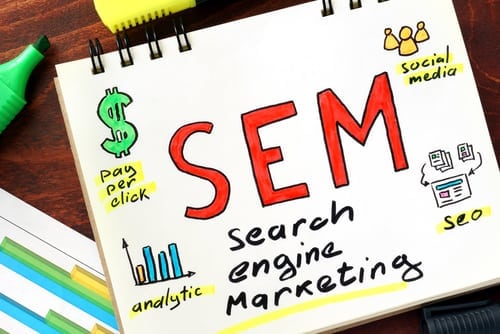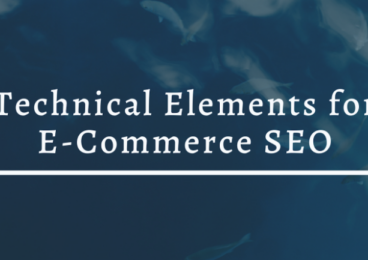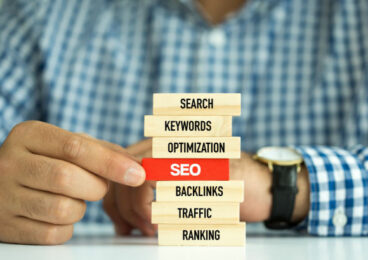 Reading Time: 5 minutes
Reading Time: 5 minutesSearch engine marketing, or SEM, is the strategy of using paid advertising to get your website to appear on the first page of the search engine results pages (SERP). Sometimes, no matter how much time and money you pour into search engine optimization (SEO) and keyword research, your website won’t show up when users search. You may simply have too much competition to make your mark – at least at first. SEM can be the answer to achieving visibility and cinching sales faster than SEO alone.
SEO vs. SEM
In the land of digital marketing, people often confuse SEO and SEM. While closely related and both under the umbrella of “search marketing,” they are two very different concepts. SEO revolves around increasing clicks organically, while SEM relies on paid advertising to show ads on the first pages of the SERP. Both are fundamental to a business’s marketing strategy today.
SEO uses a series of rules and best practices (according to Google’s ever-changing algorithms) to help a business’s website make it to the first page of search results organically, without having to pay for the position. SEM allows businesses to skip steps and make it to the top faster, helping companies achieve positive results without the wait. In essence, SEO is unpaid while SEM is paid.
The Basics of SEM
So, what is SEM? A breakdown of everything that SEM entails starts with paid search ads. Paid search advertising is just that – ads that the business owner pays for, appearing at the top of the first page of SERPs when a user searches for a certain keyword. The pay schemes differ according to the type of paid advertising a company wishes to invest in. There are a few main terms you should know when it comes to paid SEM advertisements:
- PPC (pay-per-click). PPC advertising is the most popular form of SEM. With PPC, the marketer only pays for the ad when a user clicks on the link. All the other times when the searcher sees the page but doesn’t click are free to the advertiser. Search engine PPC advertising charges a small fee for each click, but the potential returns on investment (ROI) are much greater than the fee. For example, if you pay $3 for the click but the user purchases $100 in goods, you’ve made a considerable profit.
- CPA (cost-per-acquisition). Your CPA is the total cost of your PPC campaign divided by the conversions you secured. Calculating your CPA will help you determine whether your paid SEM strategy is resulting in a profit or costing more than you’re making. CPA can help you understand the financial impact of your marketing campaign. You can determine an acceptable CPA by calculating the average order value (AOV) and customer lifetime value (CLV) of your business.
- CPC (cost-per-click). CPC refers to the actual cost of each click in a PPC marketing campaign. It is an average of bids against your competitors over a certain amount of time. Your CPC will be equal to or less than your maximum keyword bid. Calculating CPC is the Competitor Ad Rank divided by your Quality Score, plus $.01. Understanding your CPC can help you know how much to bid. The average CPC across all industries is $2. Use a CPC calculator to see where you stand in your industry.
- CPM (cost-per-thousand-impressions). CPM refers to how much 1,000 advertisement impressions on a webpage cost the marketer. For example, if the site charges $2 CPM, that means you’ll pay $2 for every 1,000 impressions of your ad. (The M is the Roman numeral for 1,000.) CPM is the most common price scheme for web ads. You can measure the ROI of your CPM campaign by analyzing your click-through rates, or how often users click your ad compared to the number of impressions.
Your SEM strategy will change according to your budget and advertising goals. All forms of paid SEM, however, rely on keyword research. You must bid on certain keywords for your advertisements to appear when users search for those words. To appear on the SERP for “digital marketing firm,” for example, you would need to win a bid on those keywords. To succeed with paid search advertising, you must first master keyword research and bidding.
How to Perform SEM Keyword Research
Before you can start with SEM, you must first understand which keywords are right for your company to bid on. Keyword research can seem daunting if you’re new, but it’s relatively simple thanks to the resources available. First, brainstorm for keywords that make sense for your brand. Create a list of terms that relate to your brand, generic terms, terms related to generic terms, and competitor terms. Put yourself in your target customer’s shoes and think of which terms he or she would use to come upon your brand.
Next, use a research tool such as Google Keyword Planner to dive deeper into keyword research. Enter the keywords on your list to find other related keywords. You’ll also see the search volume for each word, as well as how competitive the PPC bidding is for that word. The more competition the keyword has, the more you’ll have to bid to win. The ideal situation is finding a keyword with high search volume but low competition. You’ll get the best price and reach your target audience first. WordStream, Soovle, and Ubersuggest also offer keyword research tools.
Which Paid Search Platform Is Right for You?
Maximize the success of your SEM campaign by using the right platform for your specific needs, or a combination of different platforms. The best-known is Google Ads, where you can create an account for free and start bidding right away. With Google Ads, you’ll only pay when someone clicks on or engages with your ad. You can start bidding at any budget! Two other SEM platform options are as follows:
- Bing Ads. Bing’s SEM solution shows ads on the Bing Network – currently catering to around six billion searches per month. There’s no minimum fee, you only pay for clicks, and you can test keywords and bids to maximize ROI. Note that Yahoo: Search Ads and Bing are on the same network.
- Social network PPC ad options. Social networks also offer SEM ad campaigns. Facebook Ads, for example, allow you to run advertisements on Facebook, Instagram, and other apps/sites in the Audience Network. Just set your budget, choose your ad format, and place a bid at auction. When users sign into your chosen social network, they’ll see your ad campaign.
Knowing the best outlet to place your paid ads depends on your goals, company, and budget. You might want to advertise through all outlets for maximum coverage and visibility, or pick and choose the best locations for your ads depending on your desired customer demographic or marketing goals.
Get Professional Help with SEM
Paid search engine marketing can transform your business. It can take you from the third or fourth page of the SERP to the very top of the first page. SEM is one of the most affordable and effective types of advertising, with options suitable for any budget. Paid search ads can boost brand visibility, increase site traffic and click-throughs, seal more conversions, and ultimately help you gain organic recognition and business.
Get professional help with your SEM strategy and PPC ad campaigns at Vizion Interactive. Our Paid Search Program Management services provide expert guidance on how to achieve remarkable ROI on Google AdWords, Bing Ads, and more. Contact us to learn more about our monthly PPC management services.
At Vizion Interactive, we have the expertise, experience, and enthusiasm to get results and keep clients happy! Learn more about how our status as a Google Partner, along with our PPC Management, Google Shopping Ads, Social Media Advertising, Amazon Advertising, and other Paid Media services can increase sales and boost your ROI. But don’t just take our word for it, check out what our clients have to say, along with our case studies.




